Corrosion Protection of Q235 Steel Using Epoxy Coatings Loaded with Calcium Carbonate Microparticles Modified by Sodium Lignosulfonate in Simulated Concrete Pore Solutions
Abstract
1. Introduction
2. Experimental Procedures
2.1. Synthesis of SLS/CaCO3
2.2. Preparation of the Epoxy Coating
2.3. Materials and Sample Preparation
3. Characterization of the Particles and Coated Samples
3.1. Scanning Electron Microscopy
3.2. X-ray Diffraction
3.3. ATR-FTIR
3.4. UV–Vis Spectrum
3.5. Electrochemical Experiments
3.6. Water Absorption Test
3.7. Contact Angle Tests
3.8. Adhesion Measurements
3.9. Pencil Hardness Mechanical Test
4. Result and Discussion
4.1. Characterization of the Calcium Carbonate Particles
4.2. Corrosion Inhibition Performance of CaCO3 Containing-Epoxy Coating
4.2.1. Open Circuit Potential (OCP)
4.2.2. Electrochemical Impedance Spectroscopy (EIS)
4.2.3. Potentiodynamic Polarization Measurement
4.2.4. Physical Properties of Epoxy Composite Coatings
4.3. Mechanism of Inhibition Protection
5. Conclusions
- The CaCO3 microparticles modified with sodium lignosulfonate had the same oval-shaped morphology as the unmodified one.
- XRD results showed that the CaCO3 particles with or without SLS contain both the vaterite and calcite phases. Presence of sodium lignosulfonate in the CaCO3 particles leads to more calcite phase.
- The SLS loaded into the CaCO3 micro-containers can be released under different pH conditions, with the extent of sodium lignosulfonate release in the acidic media being higher.
- Electrochemical measurements demonstrated the beneficial role of the SLS/CaCO3 microparticles on the inhibition performances of the epoxy coating, especially the epoxy-5 wt% SLS/CaCO3 coating. These microparticles show better compatibility with the original epoxy coating.
- The epoxy-SLS/CaCO3 coating showed high hydrophobicity and good mechanical strength and exhibited better adhesion on the substrate.
Author Contributions
Funding
Data Availability Statement
Conflicts of Interest
Abbreviation
| SLS | Sodium lignosulfonate |
| CaCO3 | Calcium carbonate |
| SCP solution | Simulated concrete pore solution |
| SLS/CaCO3 | Calcium carbonate microparticles loaded with SLS |
| SEM | Scanning electron microscope |
| UV-vis | UV–VIS spectrophotometer |
| XRD | X-ray diffraction |
| ATR-FTIR | attenuated total reflection-Fourier-transform infrared spectroscopy |
| OCP | Open-circuit potential |
| EIS | Electrochemical impedance spectroscopy |
| Epoxy-3 wt%SLS/CaCO3 coating | The epoxy coating modified by the 3 wt% calcium carbonate particles loaded with sodium lignosulfonate |
| Epoxy-5 wt%SLS/CaCO3 coating | The epoxy coating modified by the 5 wt% calcium carbonate particles loaded with sodium lignosulfonate |
References
- Hu, J.; Zhu, Y.; Hang, J.; Zhang, Z.; Ma, Y.; Huang, H.; Yu, Q.; Wei, J. The effect of organic core—shell corrosion inhibitors on corrosion performance of the reinforcement in simulated concrete pore solution. Constr. Build. Mater. 2021, 267, 121011. [Google Scholar] [CrossRef]
- Zhang, P.; Dai, Y.; Wang, W.; Yang, J.; Mo, L.; Guo, W.; Bao, J. Effects of magnesia expansive agents on the self-healing performance of microcracks in strain-hardening cement-based composites (SHCC). Mater. Today Commun. 2020, 25, 101421. [Google Scholar] [CrossRef]
- Zhang, P.; Wittmann, F.H.; Vogel, M.; Müller, H.S.; Zhao, T. Influence of freeze-thaw cycles on capillary absorption and chloride penetration into concrete. Cem. Concr. Res. 2017, 100, 60–67. [Google Scholar] [CrossRef]
- Yuan, X.; Wang, X.; Cao, Y.; Yang, H. Natural passivation behavior and its influence on chloride-induced corrosion resistance of stainless steel in simulated concrete pore solution. J. Mater. Res. Technol. 2020, 9, 12378–12390. [Google Scholar] [CrossRef]
- Ann, K.Y.; Ahn, J.H.; Ryou, J.S. The importance of chloride content at the concrete surface in assessing the time to corrosion of steel in concrete structures. Constr. Build. Mater. 2009, 23, 239–245. [Google Scholar] [CrossRef]
- Etteyeb, N.; Dhouibi, L.; Takenouti, H.; Alonso, M.C.; Triki, E. Corrosion inhibition of carbon steel in alkaline chloride media by Na3PO4. Electrochim. Acta 2007, 52, 7506–7512. [Google Scholar] [CrossRef]
- Fazayel, A.S.; Khorasani, M.; Sarabi, A.A. The effect of functionalized polycarboxylate structures as corrosion inhibitors in a simulated concrete pore solution. Appl. Surf. Sci. 2018, 441, 895–913. [Google Scholar] [CrossRef]
- Wu, M.; Ma, H.; Shi, J. Enhanced corrosion resistance of reinforcing steels in simulated concrete pore solution with low molybdate to chloride ratios. Cem. Concr. Compos. 2020, 110, 103589. [Google Scholar] [CrossRef]
- Montemor, M.F. Functional and smart coatings for corrosion protection: A review of recent advances. Surf. Coat. Technol. 2014, 258, 17–37. [Google Scholar] [CrossRef]
- Weishaar, A.; Carpenter, M.; Loucks, R.; Sakulich, A.; Peterson, A.M. Evaluation of self-healing epoxy coatings for steel reinforcement. Constr. Build. Mater. 2018, 191, 125–135. [Google Scholar] [CrossRef]
- Asipita, S.A.; Ismail, M.; Majid, M.Z.A.; Majid, Z.A.; Abdullah, C.; Mirza, J. Green Bambusa Arundinacea leaves extract as a sustainable corrosion inhibitor in steel reinforced concrete. J. Clean. Prod. 2014, 67, 139–146. [Google Scholar] [CrossRef]
- Criado, M.; Sobrados, I.; Sanz, J.; Bastidas, J.M. Steel protection using sol–gel coatings in simulated concrete pore solution contaminated with chloride. Surf. Coat. Technol. 2014, 258, 485–494. [Google Scholar] [CrossRef]
- Criado, M.; Sobrados, I.; Bastidas, J.M.; Sanz, J. Steel corrosion in simulated carbonated concrete pore solution its protection using sol—gel coatings. Prog. Org. Coat. 2015, 88, 228–236. [Google Scholar] [CrossRef]
- Xiong, C.; Li, W.; Jin, Z.; Gao, X.; Wang, W.; Tian, H.; Han, P.; Song, L.; Jiang, L. Preparation of phytic acid conversion coating and corrosion protection performances for steel in chlorinated simulated concrete pore solution. Corros. Sci. 2018, 139, 275–288. [Google Scholar] [CrossRef]
- Cotting, F.; Aoki, I.V. Smart protection provided by epoxy clear coating doped with polystyrene microcapsules containing silanol and Ce (III) ions as corrosion inhibitors. Surf. Coat. Technol. 2016, 303, 310–318. [Google Scholar] [CrossRef]
- Liu, H.; Xu, D.; Yang, K.; Liu, H.; Cheng, Y.F. Corrosion of antibacterial Cu-bearing 316L stainless steels in the presence of sulfate reducing bacteria. Corros. Sci. 2018, 132, 46–55. [Google Scholar] [CrossRef]
- Liu, Y.-H.; Xu, J.-B.; Zhang, J.-T.; Hu, J.-M. Electrodeposited silica film interlayer for active corrosion protection. Corros. Sci. 2017, 120, 61–74. [Google Scholar] [CrossRef]
- Dastgheib, A.; Zarebidaki, A.; Attar, M.M. Enhanced barrier properties of epoxy coating containing CaCO3 microparticles modified with cerium nitrate. Prog. Org. Coat. 2020, 144, 105660. [Google Scholar] [CrossRef]
- Snihirova, D.; Lamaka, S.V.; Montemor, M.F. “SMART” protective ability of water based epoxy coatings loaded with CaCO3 microbeads impregnated with corrosion inhibitors applied on AA2024 substrates. Electrochim. Acta 2012, 83, 439–447. [Google Scholar] [CrossRef]
- Koga, N.; Kasahara, D.; Kimura, T. Aragonite Crystal Growth and Solid-State Aragonite–Calcite Transformation: A Physico–Geometrical Relationship via Thermal Dehydration of Included Water. Cryst. Growth Des. 2013, 13, 2238–2246. [Google Scholar] [CrossRef]
- Gal, A.; Habraken, W.; Gur, D.; Fratzl, P.; Weiner, S.; Addadi, L. Calcite crystal growth by a solid-state transformation of stabilized amorphous calcium carbonate nanospheres in a hydrogel. Angew. Chem. Int. Ed. Engl. 2013, 52, 4867–4870. [Google Scholar] [CrossRef]
- Samatya, S.; Orhan, E.; Kabay, N.; Tuncel, A. Comparative boron removal performance of monodisperse-porous particles with molecular brushes via “click chemistry” and direct coupling. Colloids Surf. A Physicochem. Eng. Asp. 2010, 372, 102–106. [Google Scholar] [CrossRef]
- Mustata, F.; Tudorachi, N.; Rosu, D. Thermal behavior of some organic/inorganic composites based on epoxy resin and calcium carbonate obtained from conch shell of Rapana thomasiana. Compos. Part B Eng. 2012, 43, 702–710. [Google Scholar] [CrossRef]
- Li, Y.; Liu, X.; Yuan, J.; Wu, M. Toughness improvement of epoxy resin mortar by incorporation of ground calcium carbonate. Constr. Build. Mater. 2015, 100, 122–128. [Google Scholar] [CrossRef]
- Poh, C.L.; Mariatti, M.; Ahmad Fauzi, M.N.; Ng, C.H.; Chee, C.K.; Chuah, T.P. Tensile, dielectric, and thermal properties of epoxy composites filled with silica, mica, and calcium carbonate. J. Mater. Sci. Mater. Electron. 2014, 25, 2111–2119. [Google Scholar] [CrossRef]
- Dieleman, C.D.; Denissen, P.J.; Garcia, S.J. Long-Term Active Corrosion Protection of Damaged Coated-AA2024-T3 by Embedded Electrospun Inhibiting Nanonetworks. Adv. Mater. Interfaces 2018, 5, 1800176. [Google Scholar] [CrossRef]
- Fan, W.; Li, W.; Zhang, Y.; Wang, W.; Zhang, X.; Song, L.; Liu, X. Cooperative self-healing performance of shape memory polyurethane and Alodine-containing microcapsules. RSC Adv. 2017, 7, 46778–46787. [Google Scholar] [CrossRef]
- Gorna, K.; Hund, M.; Vučak, M.; Gröhn, F.; Wegner, G. Amorphous calcium carbonate in form of spherical nanosized particles and its application as fillers for polymers. Mater. Sci. Eng. A 2008, 477, 217–225. [Google Scholar] [CrossRef]
- Raj, R.; Morozov, Y.; Calado, L.M.; Taryba, M.G.; Kahraman, R.; Shakoor, R.A.; Montemor, M.F. Calcium carbonate particles loaded with triethanolamine and polyethylenimine for enhanced corrosion protection of epoxy coated steel. Corros. Sci. 2020, 167, 108548. [Google Scholar] [CrossRef]
- Chong, A.S.; Manan, M.A.; Idris, A.K. Sodium lignosulfonate as sacrificial agent and effectiveness in reducing CTAB cationic adsorption onto kaolinite. J. King Saud Univ.-Eng. Sci. 2020. [Google Scholar] [CrossRef]
- Ouyang, X.; Qiu, X.; Lou, H.; Yang, D. Corrosion and Scale Inhibition Properties of Sodium Lignosulfonate and Its Potential Application in Recirculating Cooling Water System. Ind. Eng. Chem. Res. 2006, 45, 5716–5721. [Google Scholar] [CrossRef]
- Ahangar, M.; Izadi, M.; Shahrabi, T.; Mohammadi, I. The synergistic effect of zinc acetate on the protective behavior of sodium lignosulfonate for corrosion prevention of mild steel in 3.5 wt% NaCl electrolyte: Surface and electrochemical studies. J. Mol. Liq. 2020, 314, 113617. [Google Scholar] [CrossRef]
- Verbruggen, H.; Baert, K.; Terryn, H.; De Graeve, I. Molybdate-phosphate conversion coatings to protect steel in a simulated concrete pore solution. Surf. Coat. Technol. 2019, 361, 280–291. [Google Scholar] [CrossRef]
- Li, C.; Li, Y.; Wang, X.; Yuan, S.; Lin, D.; Zhu, Y.; Wang, H. Synthesis of hydrophobic fluoro-substituted polyaniline filler for the long-term anti-corrosion performance enhancement of epoxy coatings. Corros. Sci. 2021, 178, 109094. [Google Scholar] [CrossRef]
- Wang, Y.; Fan, Y.; Zhang, P.; Tian, L.; Xu, J.; Niu, S.; Ren, L.; Zhao, J.; Ming, W. Dynamically oleophobic epoxy coating with surface enriched in silicone. Prog. Org. Coat. 2021, 154, 106170. [Google Scholar] [CrossRef]
- Marotta, A.; Faggio, N.; Ambrogi, V.; Mija, A.; Gentile, G.; Cerruti, P. Biobased furan-based epoxy/TiO2 nanocomposites for the preparation of coatings with improved chemical resistance. Chem. Eng. J. 2021, 406, 127107. [Google Scholar] [CrossRef]
- Luo, J.; Kong, F.; Ma, X. Role of Aspartic Acid in the Synthesis of Spherical Vaterite by the Ca(OH)2–CO2Reaction. Cryst. Growth Des. 2015, 16, 728–736. [Google Scholar] [CrossRef]
- Sheng Han, Y.; Hadiko, G.; Fuji, M.; Takahashi, M. Crystallization and transformation of vaterite at controlled pH. J. Cryst. Growth 2006, 289, 269–274. [Google Scholar] [CrossRef]
- Sun, S.; Zhao, X.; Cheng, M.; Wang, Y.; Li, C.; Hu, S. Facile preparation of redox-responsive hollow mesoporous silica spheres for the encapsulation and controlled release of corrosion inhibitors. Prog. Org. Coat. 2019, 136, 105302. [Google Scholar] [CrossRef]
- Yan, M.; Yang, D.; Deng, Y.; Chen, P.; Zhou, H.; Qiu, X. Influence of pH on the behavior of lignosulfonate macromolecules in aqueous solution. Colloids Surf. A Physicochem. Eng. Asp. 2010, 371, 50–58. [Google Scholar] [CrossRef]
- Wei, M.; Shi, S.; Wang, J.; Li, Y.; Duan, X. Studies on the intercalation of naproxen into layered double hydroxide and its thermal decomposition by in situ FT-IR and in situ HT-XRD. J. Solid State Chem. 2004, 177, 2534–2541. [Google Scholar] [CrossRef]
- Hassan, H.H. Inhibition of mild steel corrosion in hydrochloric acid solution by triazole derivatives. Electrochim. Acta 2007, 53, 1722–1730. [Google Scholar] [CrossRef]
- Shen, Q.; Zhang, T.; Zhu, M.-F. A comparison of the surface properties of lignin and sulfonated lignins by FTIR spectroscopy and wicking technique. Colloids Surf. A Physicochem. Eng. Asp. 2008, 320, 57–60. [Google Scholar] [CrossRef]
- Etaiw, S.E.; Abd El-Aziz, D.M.; Abd El-Zaher, E.H.; Ali, E.A. Synthesis, spectral, antimicrobial and antitumor assessment of Schiff base derived from 2-aminobenzothiazole and its transition metal complexes. Spectrochim. Acta A Mol. Biomol. Spectrosc. 2011, 79, 1331–1337. [Google Scholar] [CrossRef]
- Abu-Dalo, M.A.; Al-Rawashdeh, N.A.F.; Ababneh, A. Evaluating the performance of sulfonated Kraft lignin agent as corrosion inhibitor for iron-based materials in water distribution systems. Desalination 2013, 313, 105–114. [Google Scholar] [CrossRef]
- Xu, D.; Lou, C.; Huang, J.; Lu, X.; Xin, Z.; Zhou, C. Effect of inhibitor-loaded halloysite nanotubes on active corrosion protection of polybenzoxazine coatings on mild steel. Prog. Org. Coat. 2019, 134, 126–133. [Google Scholar] [CrossRef]
- Mandal, S.; Singh, J.K.; Lee, D.E.; Park, T. Effect of Phosphate-Based Inhibitor on Corrosion Kinetics and Mechanism for Formation of Passive Film onto the Steel Rebar in Chloride-Containing Pore Solution. Materials 2020, 13, 3642. [Google Scholar] [CrossRef]
- Hamadou, L.; Kadri, A.; Benbrahim, N. Characterisation of passive films formed on low carbon steel in borate buffer solution (pH 9.2) by electrochemical impedance spectroscopy. Appl. Surf. Sci. 2005, 252, 1510–1519. [Google Scholar] [CrossRef]
- Hao, Y.; Sani, L.A.; Ge, T.; Fang, Q. Phytic acid doped polyaniline containing epoxy coatings for corrosion protection of Q235 carbon steel. Appl. Surf. Sci. 2017, 419, 826–837. [Google Scholar] [CrossRef]
- Mostafaei, A.; Nasirpouri, F. Epoxy/polyaniline–ZnO nanorods hybrid nanocomposite coatings: Synthesis, characterization and corrosion protection performance of conducting paints. Prog. Org. Coat. 2014, 77, 146–159. [Google Scholar] [CrossRef]
- Henriques, R.R.; Soares, B.G. Sepiolite modified with phosphonium ionic liquids as anticorrosive pigment for epoxy coatings. Appl. Clay Sci. 2021, 200, 105890. [Google Scholar] [CrossRef]
- Caldona, E.B.; Wipf, D.O.; Smith, D.W. Characterization of a tetrafunctional epoxy-amine coating for corrosion protection of mild steel. Prog. Org. Coat. 2021, 151, 106045. [Google Scholar] [CrossRef]
- Pourhashem, S.; Vaezi, M.R.; Rashidi, A. Investigating the effect of SiO2-graphene oxide hybrid as inorganic nanofiller on corrosion protection properties of epoxy coatings. Surf. Coat. Technol. 2017, 311, 282–294. [Google Scholar] [CrossRef]
- Li, Y.; Liu, J.; Dong, Z.; Xing, S.; Lv, Y.; Li, D. A Novel Testing Method for Examining Corrosion Behavior of Reinforcing Steel in Simulated Concrete Pore Solutions. Materials 2020, 13, 5327. [Google Scholar] [CrossRef]
- Jiang, J.Y.; Liu, Y.; Chu, H.Y.; Wang, D.; Ma, H.; Sun, W. Pitting Corrosion Behaviour of New Corrosion-Resistant Reinforcement Bars in Chloride-Containing Concrete Pore Solution. Materials 2017, 10, 903. [Google Scholar] [CrossRef]
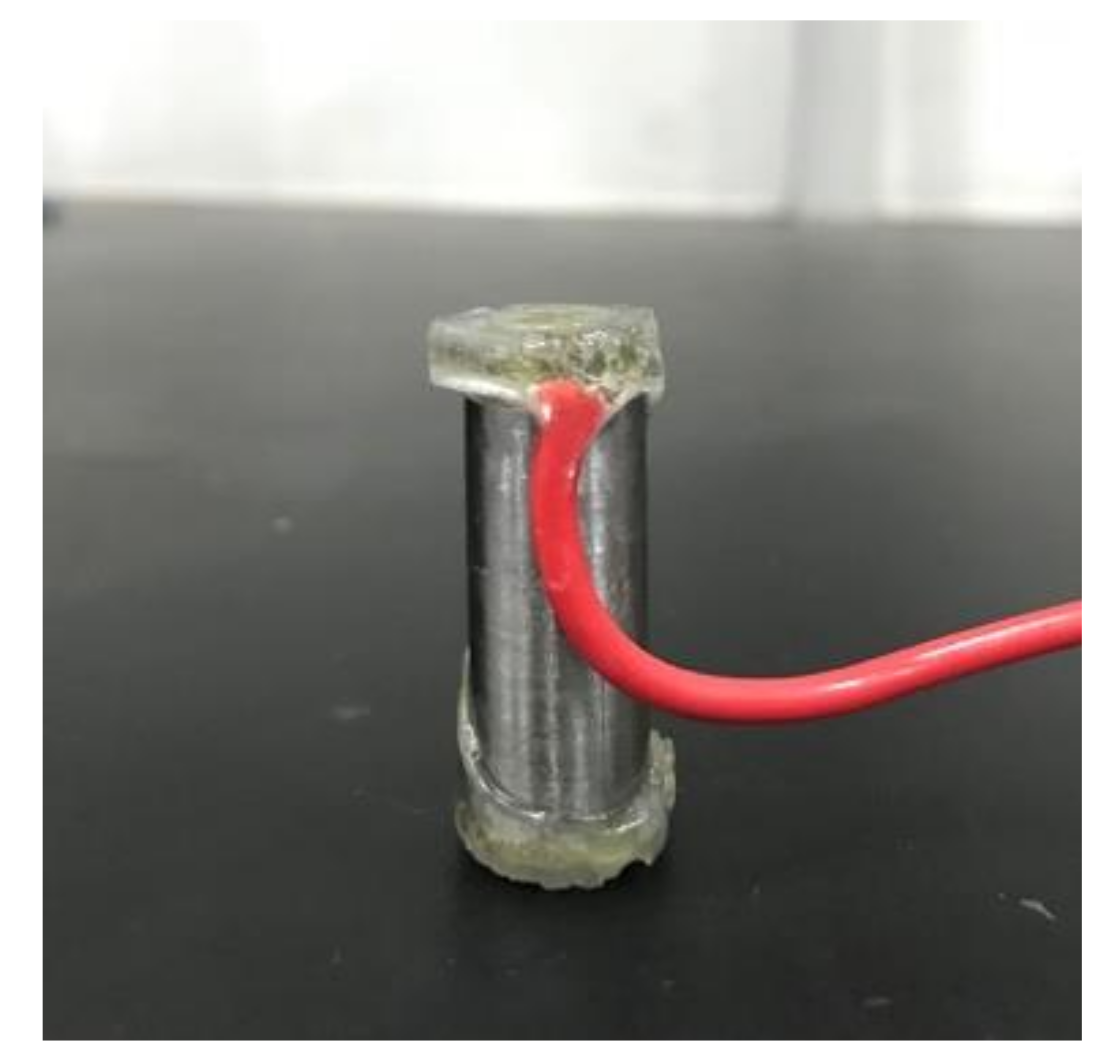
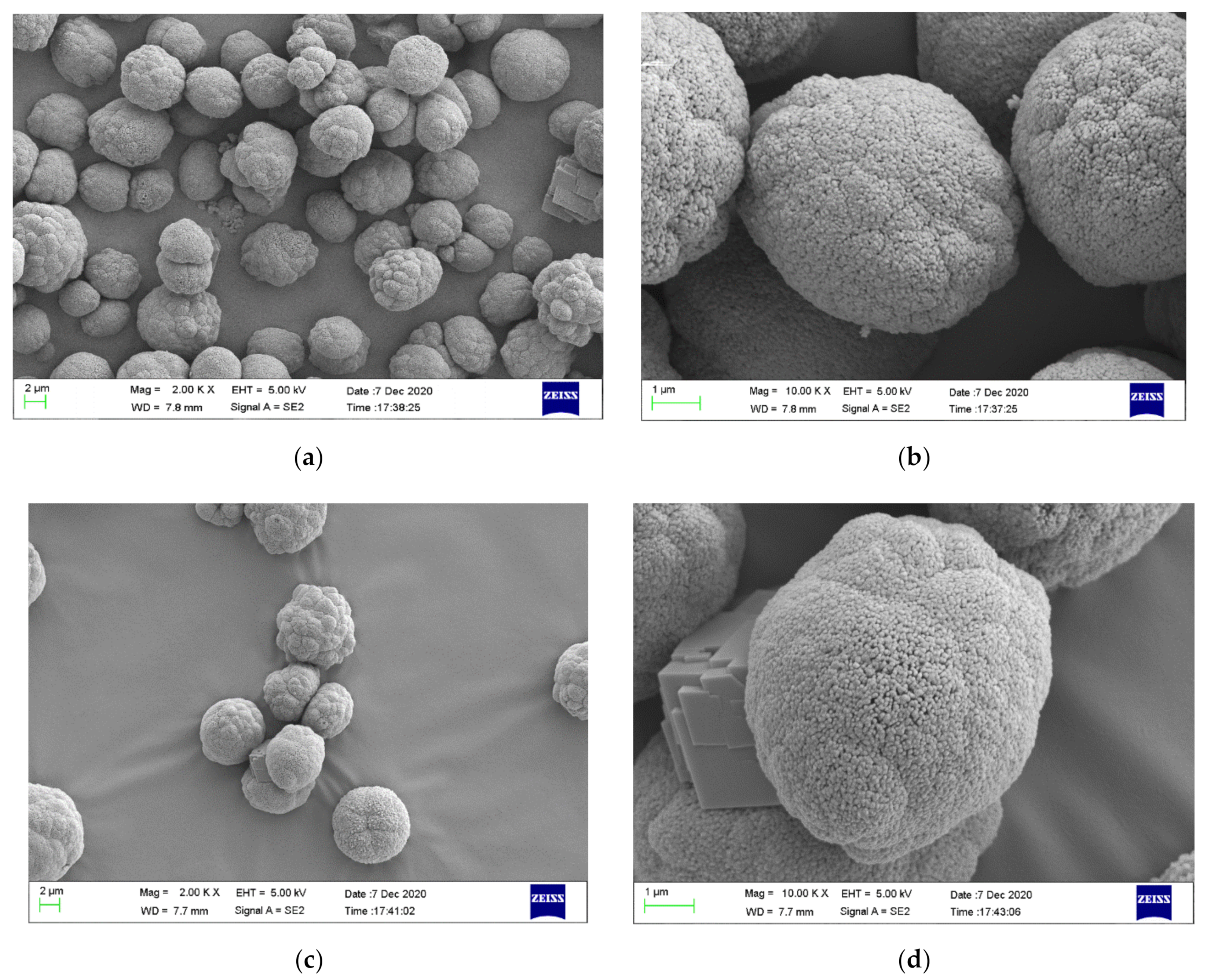
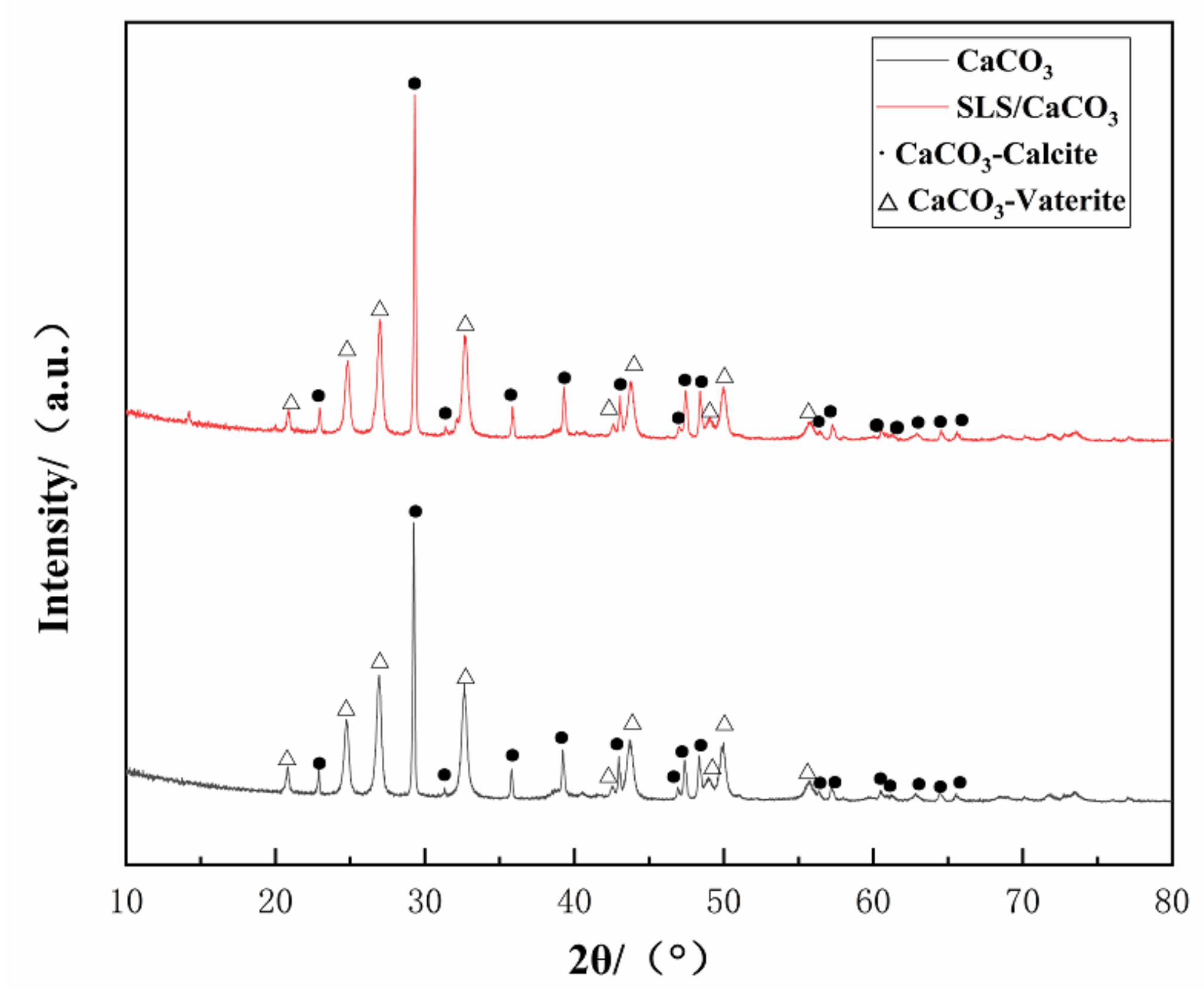
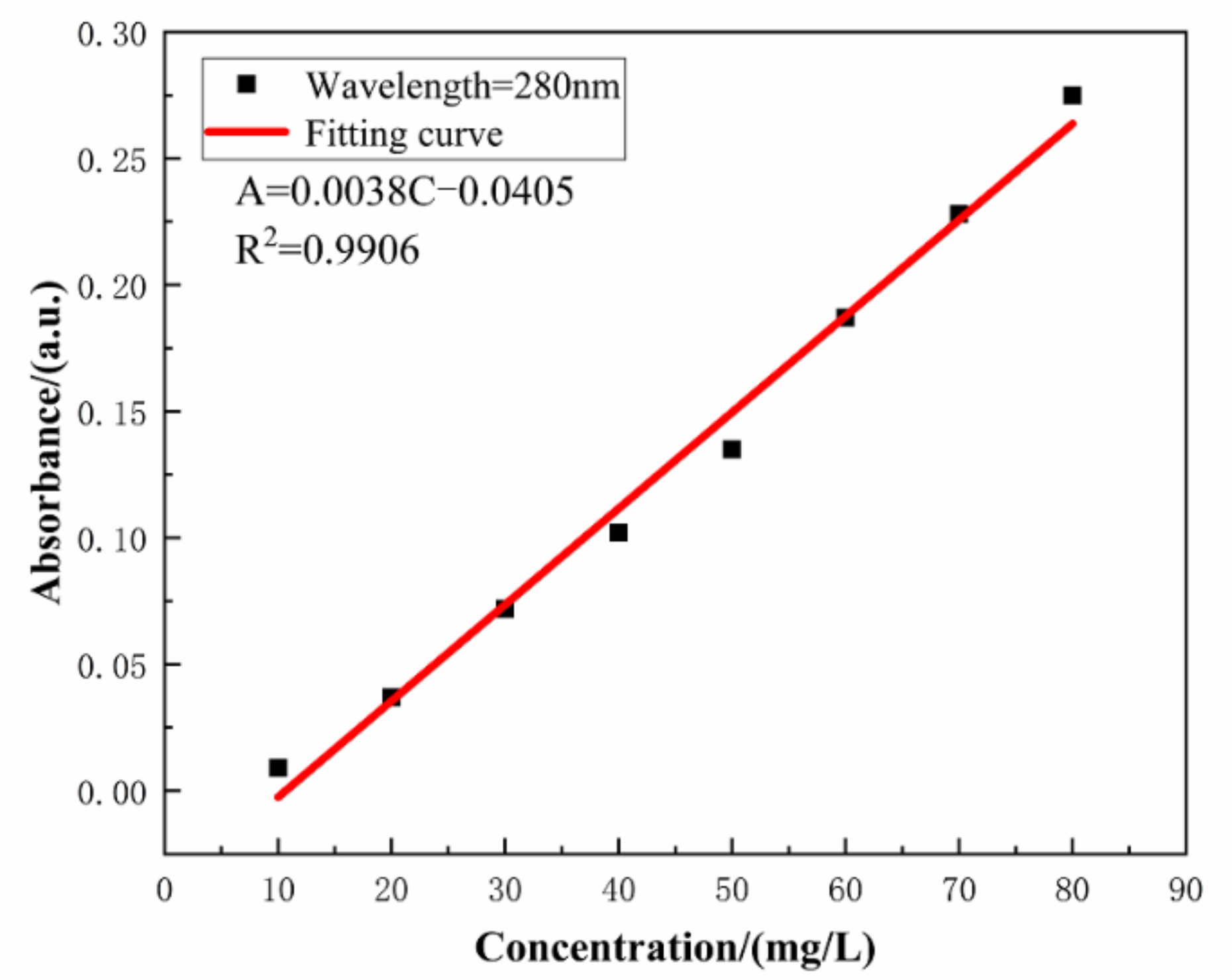

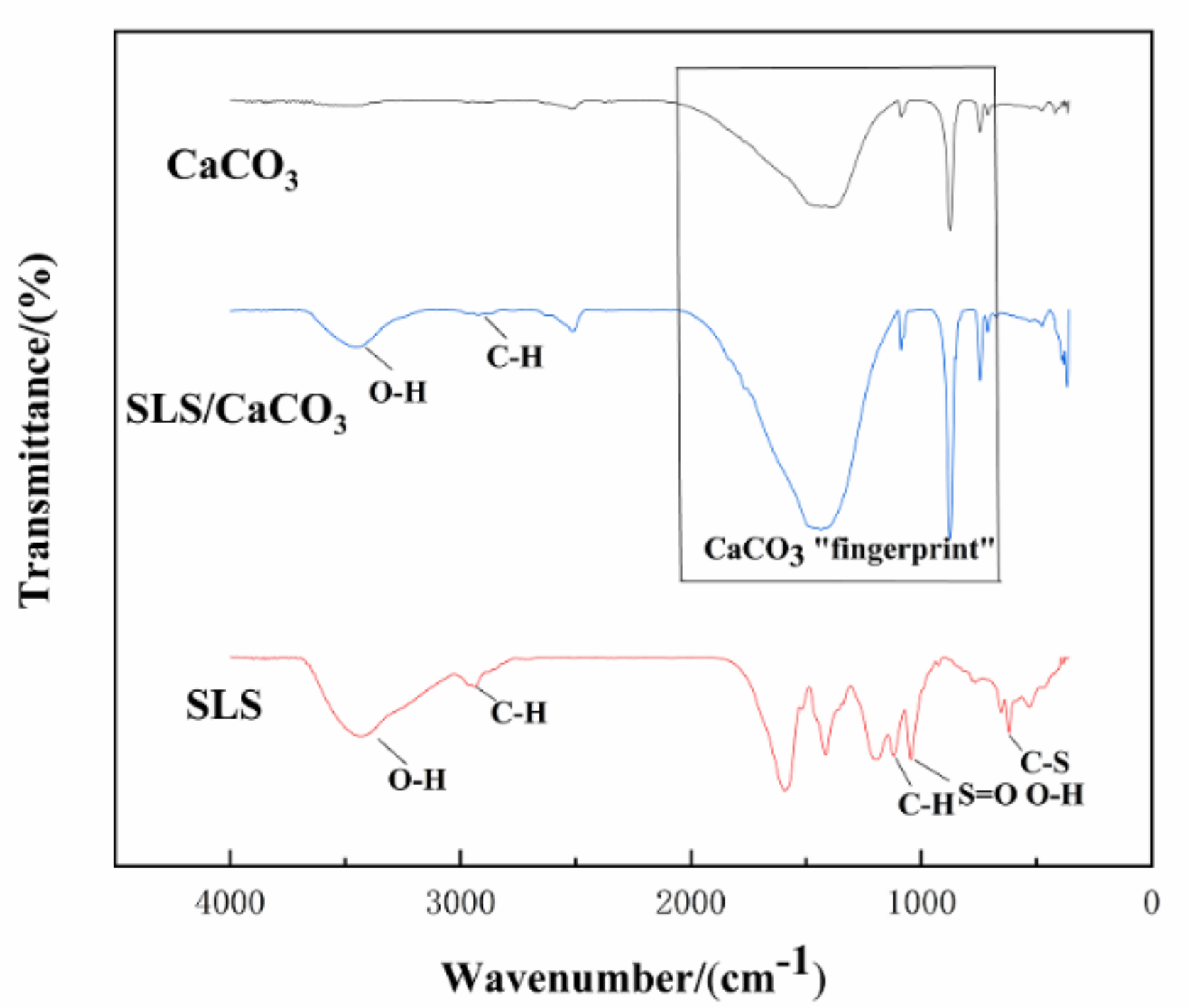
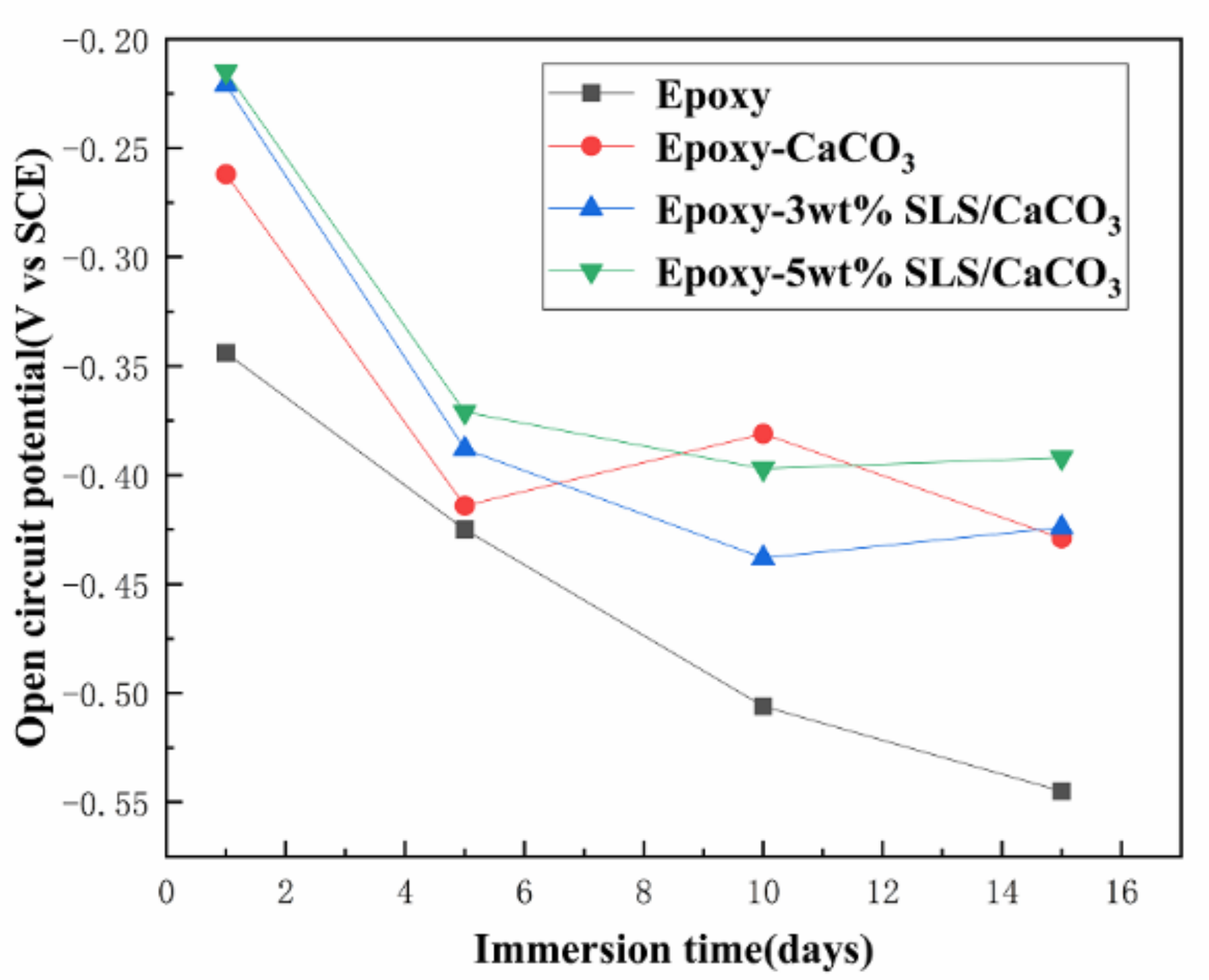

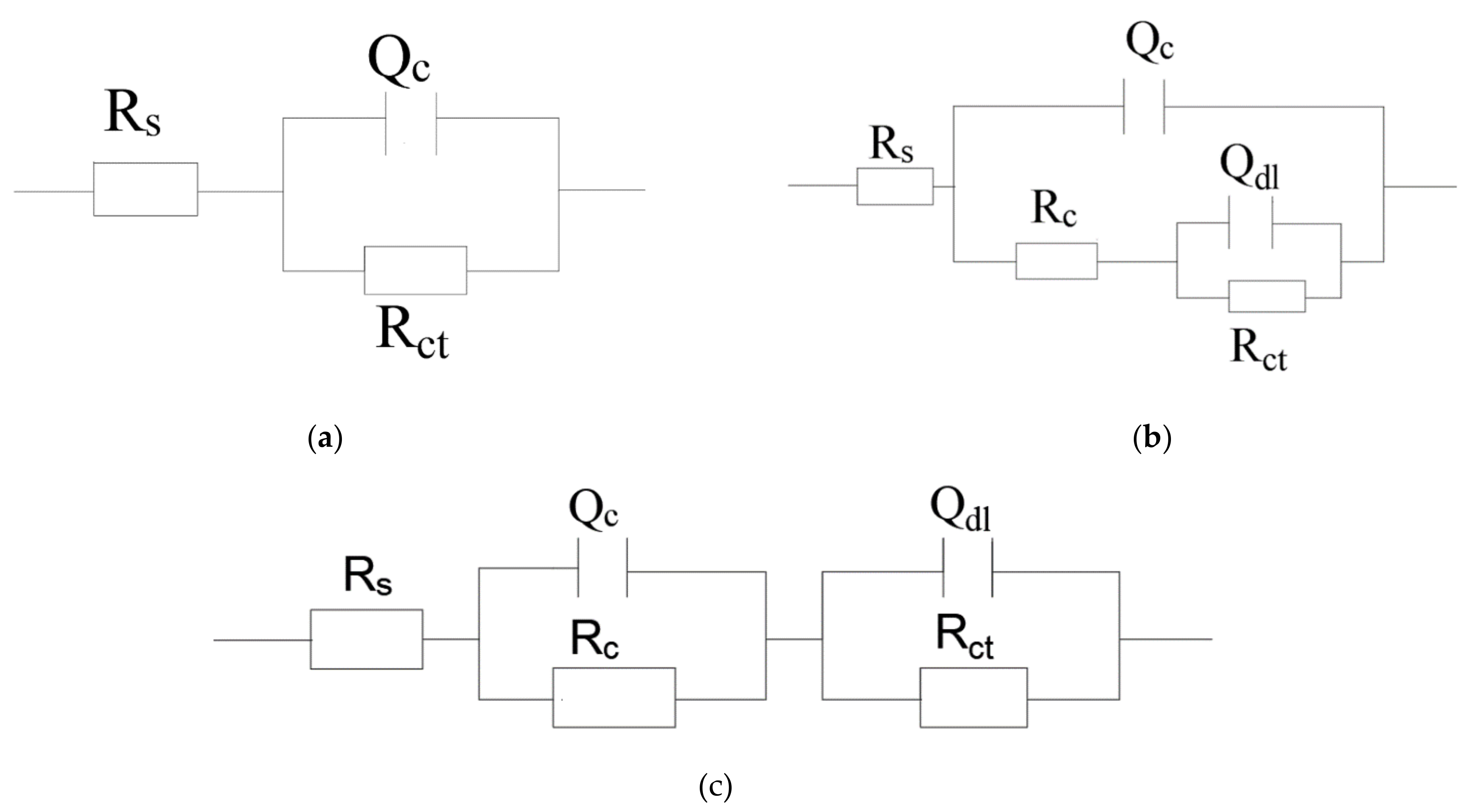
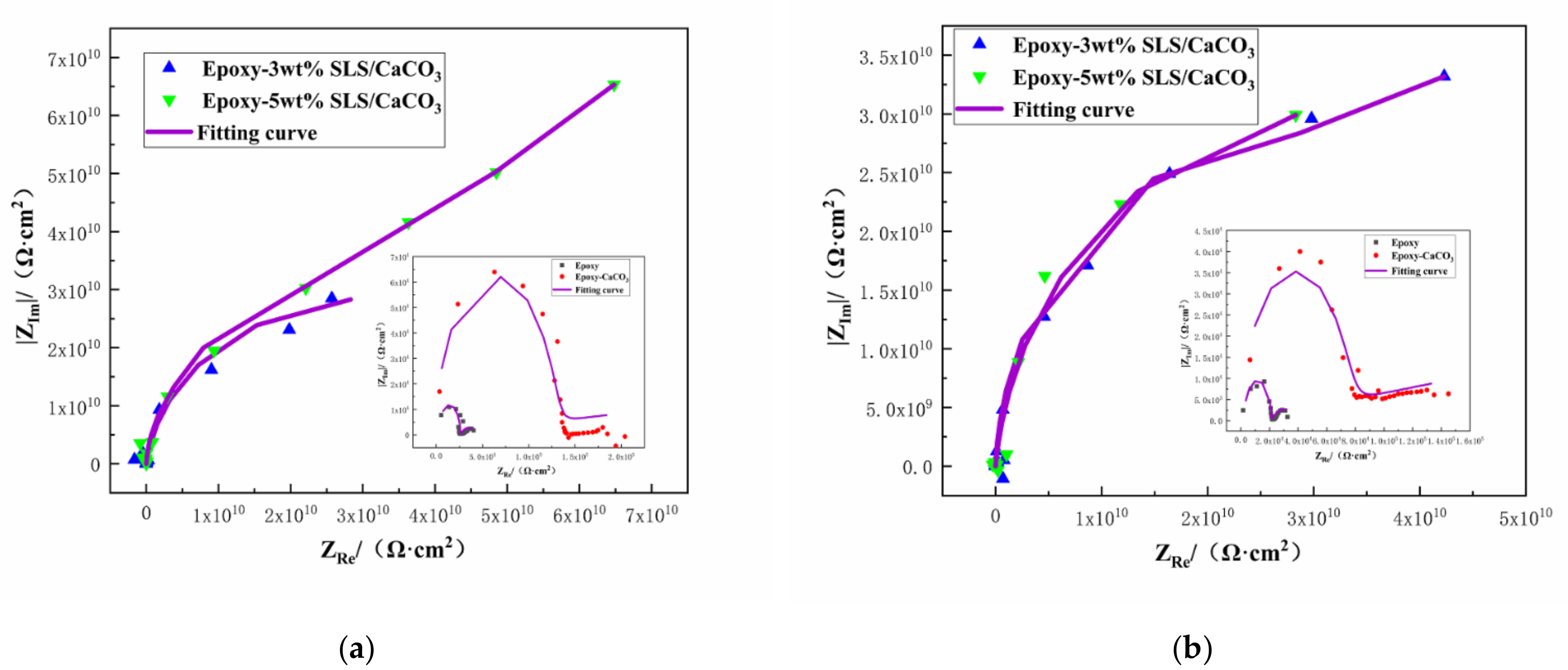

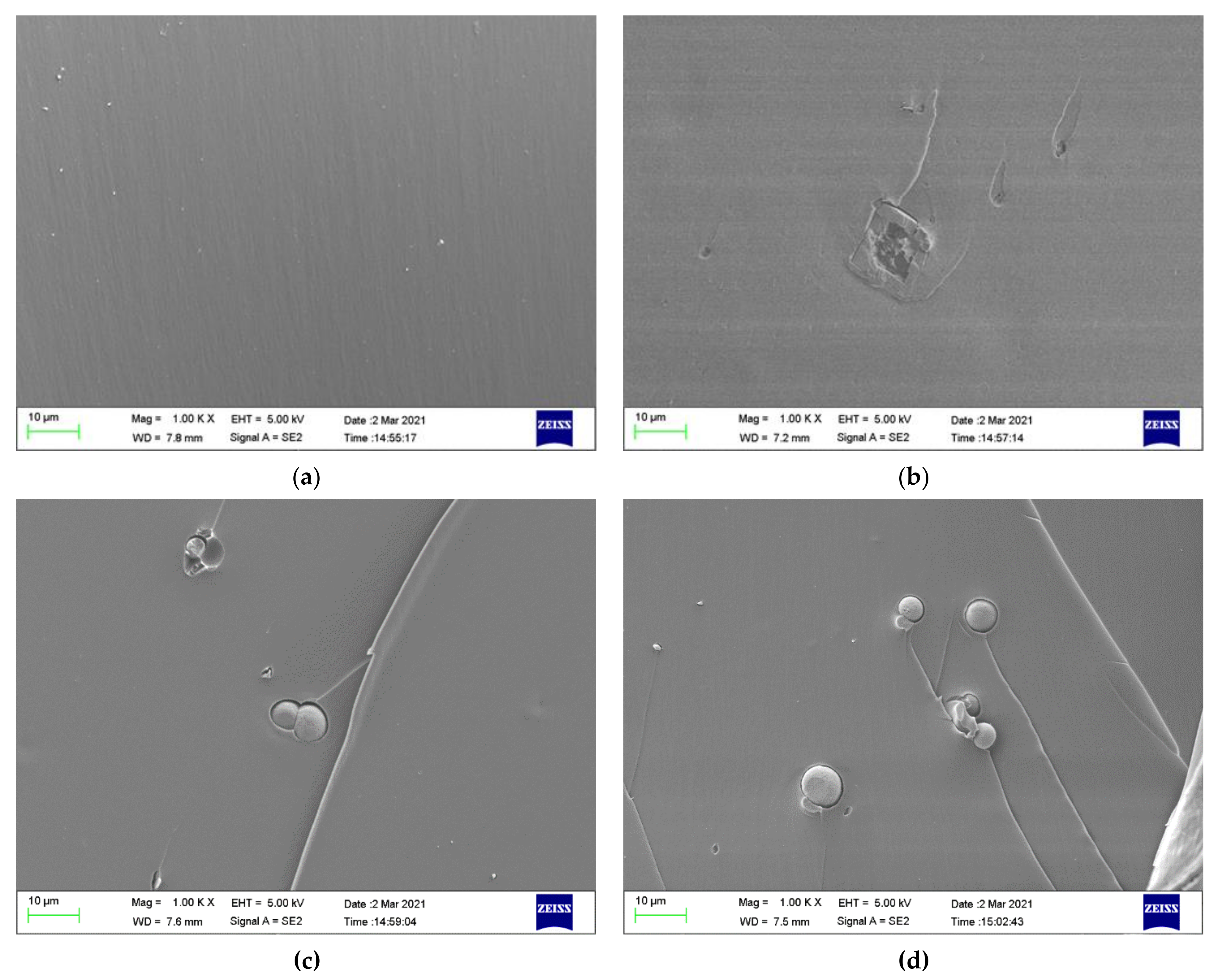


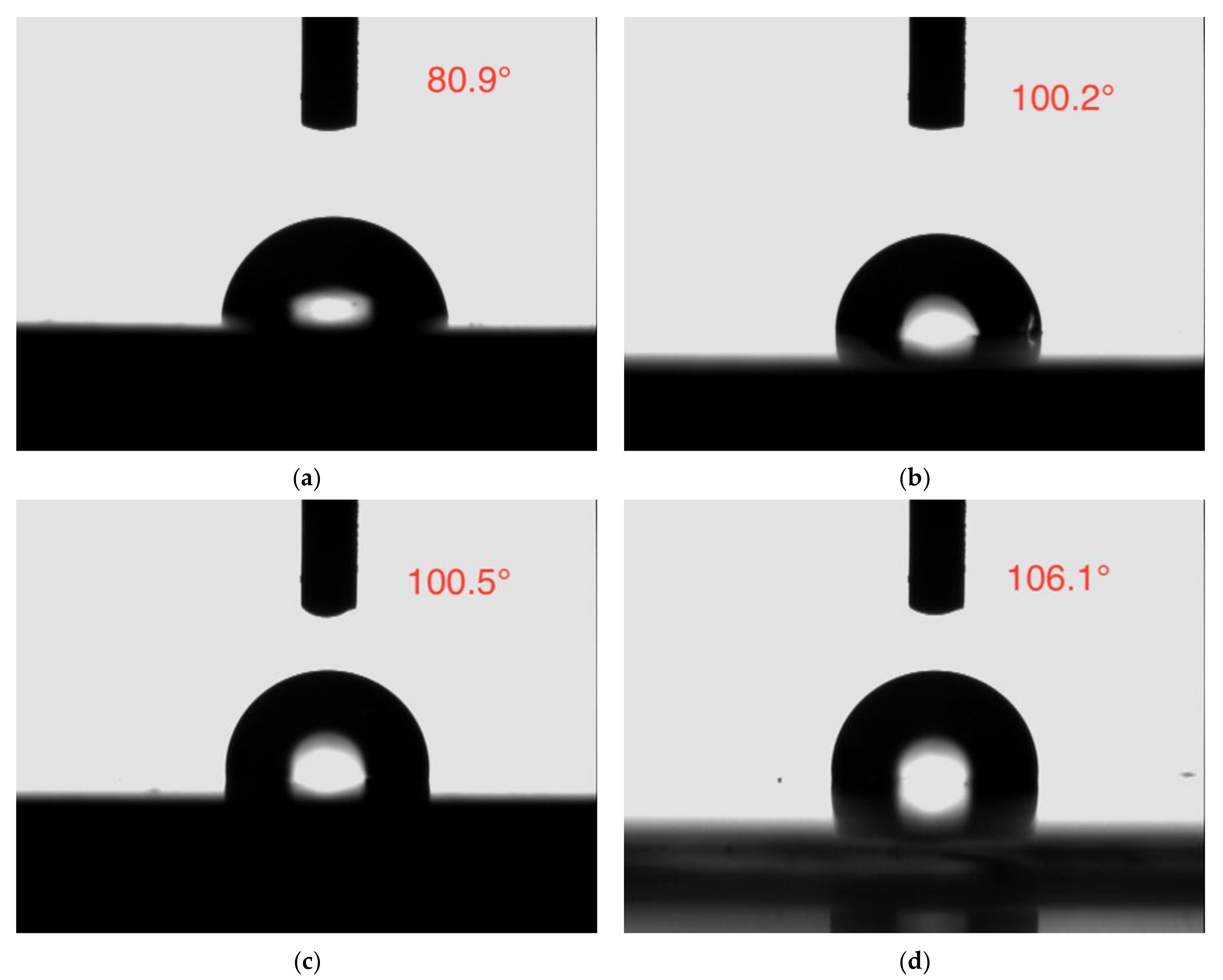
| Time/(h) | pH | Absorbance/(a.u.) | Concentration/(mg/L) |
|---|---|---|---|
| 24 | 4 | 0.107 | 38.816 |
| 7 | 0.075 | 30.395 | |
| 10 | 0.039 | 20.921 | |
| 48 | 4 | 0.104 | 38.026 |
| 7 | 0.058 | 25.921 | |
| 10 | 0.038 | 20.658 | |
| 72 | 4 | 0.094 | 35.395 |
| 7 | 0.058 | 25.921 | |
| 10 | 0.049 | 23.553 |
| Specimens | Time (Day) | Rs (Ω·cm2) | Qc (Ω−1·cm−2·sn) | n | Rc (Ω·cm2) | Qdl (Ω−1·cm−2·sn) | n | Rct (Ω·cm2) | χ2 | Equivalent Circuit |
|---|---|---|---|---|---|---|---|---|---|---|
| Epoxy | 5 | 2799 | 3.33 10−10 | 9.3 10−1 | 2.76 104 | – | – | – | 0.02710 | R(QR) |
| 15 | 2266 | 3.11 10−10 | 1 | 1.96 104 | 7.65 10−5 | 4.48 10−1 | 1.63 104 | 0.01538 | R(QR)(QR) | |
| Epoxy-CaCO3 | 5 | 0.04873 | 4.54 10−11 | 1 | 1.59 105 | – | – | – | 0.02607 | R(QR) |
| 15 | 132 | 7.10 10−11 | 2.45 10−1 | 9.53 104 | 1.01 10−5 | 1 | 7.16 104 | 0.00910 | R(QR)(QR) | |
| Epoxy-3 wt% SLS/CaCO3 | 5 | 750 | 1.22 10−10 | 9.45 10−1 | 5.20 1010 | – | – | – | 0.04723 | R (QR) |
| 15 | 2930 | 1.09 10−10 | 1 | 5.16 1010 | 1.40 10−5 | 6.12 10−1 | 1.30 1010 | 0.02086 | R(Q(R(QR))) | |
| Epoxy-5 wt% SLS/CaCO3 | 5 | 3166 | 9.03 10−11 | 1 | 9.55 1010 | – | – | – | 0.02707 | R (QR) |
| 15 | 1662 | 1.40 10−10 | 9.79 10−1 | 4.54 1010 | 7.94 10−7 | 9.99 10−1 | 4.36 1010 | 0.03265 | R(Q(R(QR))) |
| Specimens | Time (day) | Ecorr (V) | icorr (A·cm2) | IE (%) |
|---|---|---|---|---|
| Epoxy | 5 | −0.430 | 1.92 × 10−7 | − |
| 15 | −0.556 | 1.12 × 10−6 | − | |
| Epoxy-CaCO3 | 5 | −0.401 | 2.44 × 10−7 | − |
| 15 | −0.452 | 3.73 × 10−7 | 66.69 | |
| Epoxy-3wt%SLS/CaCO3 | 5 | −0.388 | 9.05 × 10−8 | 52.86 |
| 15 | −0.445 | 1.90 × 10−7 | 83.02 | |
| Epoxy-5wt%SLS/CaCO3 | 5 | −0.371 | 1.76 × 10−8 | 90.83 |
| 15 | −0.378 | 1.72 × 10−7 | 84.64 |
| Specimens | Adhesion Level |
|---|---|
| Epoxy | 1 |
| Epoxy-CaCO3 | 0 |
| Epoxy-3 wt%SLS/CaCO3 | 0 |
| Epoxy-5 wt%SLS/CaCO3 | 0 |
| Specimens | Scratch | Gauge |
|---|---|---|
| Epoxy | 6H | 4H |
| Epoxy-CaCO3 | 6H | 4H |
| Epoxy-3 wt%SLS/CaCO3 | 6H | 4H |
| Epoxy-5 wt%SLS/CaCO3 | 6H | 4H |
Publisher’s Note: MDPI stays neutral with regard to jurisdictional claims in published maps and institutional affiliations. |
© 2021 by the authors. Licensee MDPI, Basel, Switzerland. This article is an open access article distributed under the terms and conditions of the Creative Commons Attribution (CC BY) license (https://creativecommons.org/licenses/by/4.0/).
Share and Cite
Liu, W.; Li, J.; Huang, X.; Bi, J. Corrosion Protection of Q235 Steel Using Epoxy Coatings Loaded with Calcium Carbonate Microparticles Modified by Sodium Lignosulfonate in Simulated Concrete Pore Solutions. Materials 2021, 14, 1982. https://doi.org/10.3390/ma14081982
Liu W, Li J, Huang X, Bi J. Corrosion Protection of Q235 Steel Using Epoxy Coatings Loaded with Calcium Carbonate Microparticles Modified by Sodium Lignosulfonate in Simulated Concrete Pore Solutions. Materials. 2021; 14(8):1982. https://doi.org/10.3390/ma14081982
Chicago/Turabian StyleLiu, Weilin, Jiansan Li, Xiangqi Huang, and Jinye Bi. 2021. "Corrosion Protection of Q235 Steel Using Epoxy Coatings Loaded with Calcium Carbonate Microparticles Modified by Sodium Lignosulfonate in Simulated Concrete Pore Solutions" Materials 14, no. 8: 1982. https://doi.org/10.3390/ma14081982
APA StyleLiu, W., Li, J., Huang, X., & Bi, J. (2021). Corrosion Protection of Q235 Steel Using Epoxy Coatings Loaded with Calcium Carbonate Microparticles Modified by Sodium Lignosulfonate in Simulated Concrete Pore Solutions. Materials, 14(8), 1982. https://doi.org/10.3390/ma14081982





